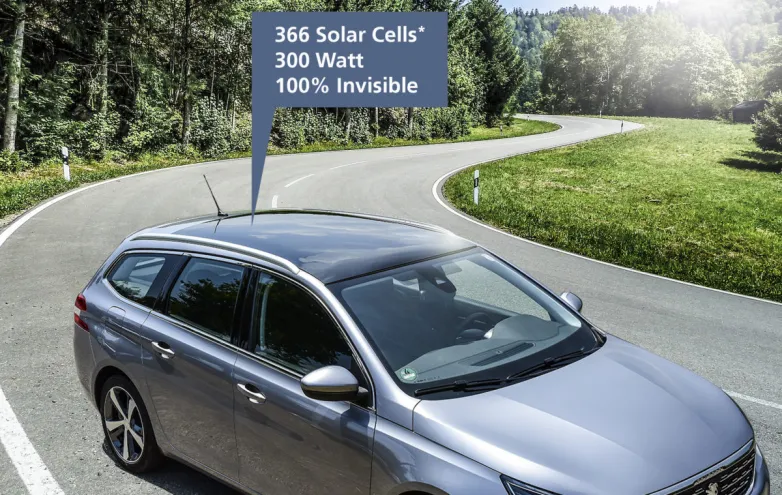Fraunhofer ISE displays colored solar car roof at auto trade fair
Sep 3, 2019 05:54 PM ET
- An increasing number of carmakers and research institutes are developing concepts that combine e-mobility and solar. Thus far, range additions from in-car panels of between 10 and 60km are the limit of innovation. The Fraunhofer roof is tinted with a color that hides the cells but lets through most of the light.

Who would have thought solar panels would steal the show at one of the world’s largest car shows?
The Fraunhofer Institute for Solar Energy Systems brought along a PV module application to its booth at the International Motor Show in Frankfurt, Germany. With electric mobility on everyone’s lips, the addition of solar modules to car bodywork is gaining traction and Fraunhofer ISE presented a car roof featuring monocrystalline silicon cells with shingle interconnections.
The integrated car roof has a maximum output of 210 W/m². On a regular station wagon roof, that would add up to around 300 W. On a sunny summer day that could extend driving range by around 10 km.
“This corresponds to an annual extension of an average mileage by approximately 10%, or an equivalent reduction in fuel consumption,” stated a Fraunhofer announcement. “The calculation is based on the unshaded solar radiation in Freiburg im Breisgau, the consumption of an electric car of 17 kWh per 100km and an annual mileage of 15,000km.” The institute claimed it would be possible to use the current generated to power air conditioning or heating, both drains on power which would otherwise limit range.
Eye-catching
The cells slightly overlap and are glued together with an electrically conductive adhesive. That ensures the entire roof surface can be used. According to the developers of the sunroof, there are lower resistance losses and improved shading tolerance as a result of the shingle architecture, translating into a 2% efficiency gain.
Fraunhofer also emphasized the aesthetics of the roof. The solar cells are laminated in a polymer-film between spherically curved glass panels, making them suitable for panorama car roofs. The glass is tinted with a special color to conceal the solar cells. With less than 2% efficiency losses, the ‘Morpho-Color’ glass coating could be a reasonable aesthetic addition that would not significantly jeopardize functionality, said its developer. The coating was reportedly inspired by the morpho butterfly and was achieved by a unique surface structure which improves color saturation and angular stability while letting through significant irradiation.
Fraunhofer ISE has explored solar panel applications for electromobility since 2016. Researchers previously equipped six trucks in the U.S. and Europe with irradiation and temperature sensors and mapped parameters over an extended period. In Europe, a typical truck roof was said to offer annual solar generation potential of 5-7 MWh.
Solar car innovation
Over the last year, manufacturers have presented solar powered car concepts. Most notably, Netherlands-based start-up Lightyear announced a solar powered car with a range of 450 miles – 40-50 of them provided by the vehicle’s bodywork. That would add up to almost nine times the range offered by the Fraunhofer sunroof.
Having added a 180 W sunroof to its Prius model in 2017, Japanese carmaker Toyota teamed up with Sharp and the New Energy and Industrial Technology Development Organization to develop a cell tech that purported to offer a massive 34% conversion efficiency. The triple-junction cell combines indium gallium phosphide (InGaP), gallium arsenide (GaAs) and indium gallium arsenide (InGaAs). The cells cover the bonnet, roof and boot lid, providing an extra 860 W. Toyota claimed the range gain would come in at 40-60km.
Hyundai too, equipped its Sonata model with a solar roof it said could provide 1300km of extra driving range per year.
Manufacturers have to grapple with the challenge of supplying the right current and voltage from the solar roof while the car is moving. The 2017 solar Prius, as well as the Hyundai Sonata, can only charge batteries when idle.
Toyota, though, subsequently announced its updated Prius could extend range while on the go. The Lightyear too has a smaller battery which relies on the car’s 16ft² solar roof to extend range.
Also read
